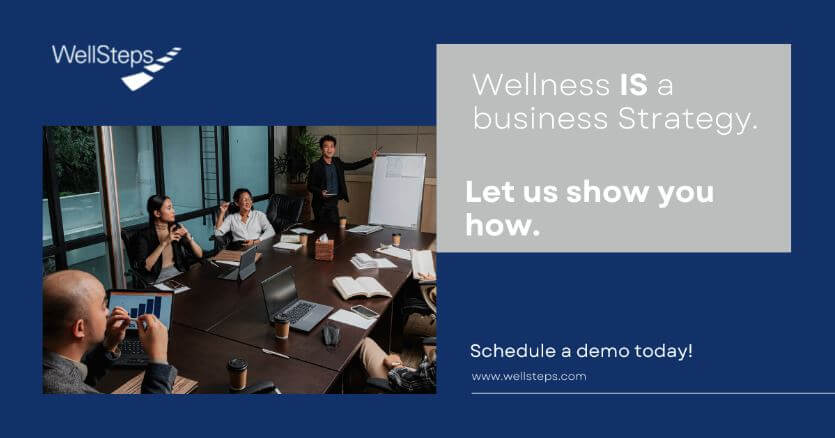When leadership actively participates in wellness programs, it has a profound impact on employee engagement and morale. But, how can leaders improve workplace wellness? Keep reading…
If employees don’t see leaders prioritizing their own health, they may question leadership’s commitment to their well-being. To inspire participation, here are eight actionable strategies leadership can use to actively support wellness programs and foster a healthier company culture. Need the Cliff Notes? Check out our leadership support infographic, where we explore six specific things leadership can do to support wellness.
Eight Proven Strategies
1. Participate in Current Wellness Campaigns
Employee well-being directly affects company success. Leaders should demonstrate their commitment by actively engaging in wellness campaigns. If employees don’t see leaders participating in wellness challenges or programs, their enthusiasm may wane. It’s important for leaders to not just talk about the benefits of these campaigns but to take part in them. Lead by example—join the challenges, share your progress, and encourage others to get involved. Your engagement shows that wellness is a priority for everyone in the organization, not just employees.

2. Set Personal Health Goals and Share Your Journey
Growth is vital—both for individuals and organizations. As a leader, having clear personal health goals and sharing them with your team creates a sense of relatability and encourages transparency. Discuss the challenges you face in achieving your wellness goals and how the company’s wellness programs help you along the way. When employees see leaders actively pursuing their health goals, it motivates them to take their own steps toward better health. Be open about the difficulties you encounter, and share how you plan to overcome them. This authenticity helps employees feel more connected to the wellness initiatives.
3. Take the Stairs, Not the Elevator
Simple actions can speak volumes. Leaders who opt for the stairs instead of the elevator set an example for their teams. Taking the stairs may seem like a small gesture, but when leaders mention it—such as saying, “I want to get my steps in for the day”—it makes a noticeable impact. Even if you have a long journey ahead, taking a few flights of stairs before using the elevator reinforces the idea that small choices contribute to overall wellness. Encourage your team to adopt similar habits, such as walking instead of driving short distances. By making these choices a part of your daily routine, you’ll inspire your employees to do the same.
4. Read Books to Expand Wellness Knowledge
Leaders who invest in their own wellness knowledge set a powerful example for employees. Reading books that discuss the importance of wellness—such as The Culprit and the Cure, which examines lifestyle diseases and their connection to workplace culture—demonstrates a genuine commitment to the well-being of employees. When you share what you learn, it not only educates your team but shows that you’re continuously striving to improve both personally and professionally. When employees see that leadership is making an effort to better understand wellness, they are more likely to trust and engage in wellness programs. Share insights from these resources during team meetings, webinars, or through internal communications.

5. Share Photos of Leadership at Company Events
Visibility matters when it comes to leadership support. Make sure to share photos of yourself and other leaders participating in company wellness events. Whether it’s a race, health seminar, or volunteer activity, these moments help reinforce that wellness is a company-wide initiative. Post pictures to company social media accounts or include them in internal newsletters to show the entire team that leadership is engaged. It’s important to highlight both leaders and employees in these photos to emphasize inclusivity. The more employees see leadership actively involved, the more they will feel motivated to participate in future wellness activities.
6. Attend Company Webinars and Online Events
In today’s hybrid and remote work environments, online events provide a great opportunity for leaders to engage with employees on wellness topics. Leaders can participate in company webinars, virtual fitness classes, or live Q&A sessions, showing employees that wellness is a priority for everyone. It’s important that leaders stay engaged throughout the entire event, not just make a brief appearance. This demonstrates genuine interest in both the event and the employees involved. Leaders can use these platforms to share their experiences, extend invitations to upcoming wellness events, and express gratitude for employees’ participation in wellness initiatives. By participating in virtual events, you show that wellness is an ongoing conversation, regardless of location.
7. Collaborate with Wellness Committees and Focus Groups
Wellness committees are vital in shaping successful wellness programs, but their efforts need leadership involvement to be truly effective. High-level leaders should work alongside wellness committees and focus groups to develop and manage wellness initiatives that resonate with the entire organization. Bring leadership into focus group meetings, or at least review the results of employee feedback. This approach helps ensure that wellness initiatives are aligned with employee needs and the company culture. When employees see leadership taking an active role in wellness discussions, it fosters a sense of ownership and collective effort across all levels of the company.

8. Share Healthy Recipes with Employees
Food is a powerful tool for building a wellness culture. Share your favorite healthy recipes with employees through wellness emails, newsletters, or internal communication platforms. Tailor the recipes to align with current wellness challenges—whether it’s a nutritious meal to fuel a 5k run or a heart-healthy recipe for a company health campaign. Sharing recipes not only encourages employees to eat healthier, but it also shows that leadership values wellness beyond physical activities. A leader’s willingness to share their personal wellness tips can inspire employees to adopt healthier eating habits and try new foods that contribute to their well-being.
Next Steps to Support Wellness Program Participation
Now that we know how leaders can improve workplace wellness, what’s next?
As a leader, promoting wellness within your organization can seem daunting with so many responsibilities on your plate. Fortunately, you don’t have to do it alone. WellSteps offers a comprehensive wellness platform that streamlines the process, helping you manage and optimize wellness programs while you focus on other key tasks. Our team works alongside yours to ensure your wellness initiatives are effective, engaging, and tailored to your organization’s needs.
Schedule a free demo with WellSteps today to discover how we can simplify your wellness program management. We’ll help you create lasting, impactful changes that benefit both your employees and your company. Don’t wait—connect with us now to get started on your wellness journey!
Learn more about WellSteps Wellness Solutions.

Great insights! The way you’ve presented the information makes it easy to understand and very impactful. Keep up the great work.
Comments are closed.